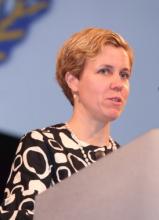MINNEAPOLIS – The number of residents failing the American Board of Thoracic Surgery exams has risen significantly in the wake of reduced residency hours, a new study confirms.
The change is particularly alarming for the ABTS oral boards, Dr. Susan Moffatt-Bruce reported at the annual meeting of the American Association for Thoracic Surgery.
The failure rate for the oral exams doubled from 14.4% to 28.1% between 2000 to 2005 and 2006 to 2011, the 6 years before and 6 years after the Accreditation Council for Graduate Medical Education imposed an 80-hour residency work week. By 2012, 30% of residents were failing the oral exam.
Of the 903 residents who took the written exam between 2000 and 2005, 10.6% failed, compared with 17.4% of the 672 residents writing the exam between 2006 and 2007. By 2012, however, the success rate reached 85.4%.
Although the percentage failing the written exam was lower than for the oral exams in both time periods, it remained significantly higher from 2006 to 2011 than before the 80-hour work week requirement (12% vs. 21%) said Dr. Moffatt-Bruce, a cardiothoracic surgeon at the Ohio State Medical Center in Columbus.
"There are a decreasing number of trainees, and we will not meet the needs of a growing American population," she said, observing that the shortfall of certified cardiothoracic surgeons could be realized as early as 2020.
Dr. Moffatt-Bruce speculated that the higher failure rate for the oral exams could be the result of a decrease in the number of critical cardiac cases and in experiential learning for thoracic surgery residents, particularly on the weekends and evenings.
"It is very hard to pass an oral exam question about a scenario that you may never have encountered as a resident," she said.
Since 2000, the number of new certificates awarded by the ABTS has decreased steadily from a peak of 126 certificates in 2002 to 93 certificates in 2011. An additional 100 residents would need to be trained to meet the need for cardiothoracic surgeons by 2030, Dr. Moffatt-Bruce said.
She was careful to acknowledge existing efforts by various groups to attract students, such as the 6-year Integrated Cardiothoracic Surgery Residency Program (I-6), but she said additional strategies are needed to improve not only the number of trainees, but also the way in which they learn.
During a discussion of the results, Dr. Edward Verrier, surgical director, Joint Council of Thoracic Surgery Education, said various societies have gotten together and this spring will roll out a completely new content management system for the cardiothoracic surgery curriculum as well as a new curriculum and learning management tool that will help track issues related to competency and various milestones.
"It’s very important to recognize that these issues have been on the table; they’ve been very carefully thought out at the board level, the society level and by some of the other organizations dedicated to education, and we will see significant transitions over the next year," he said.
Dr. Teresa Kieser, a cardiothoracic surgeon with University of Calgary in Canada, said that more than half of medical school graduates in Canada are women, but that perhaps women aren’t choosing cardiothoracic surgery as a career.
Dr. Moffatt-Bruce, who trained in both the U.S. and Canada, agreed there are challenges facing women in cardiothoracic surgery, but said the curriculum needs to be more attractive to everyone and that providing experiences early on in the medical school curriculum and environment will entice residents "to see that this really is a great career choice, that this is the way of the future and that the need is going to be very real. We have to set the burning platform for everyone and we can do that very easily as an association with the various societies."
Dr. Moffatt-Bruce and her coauthors reported having no financial disclosures.


